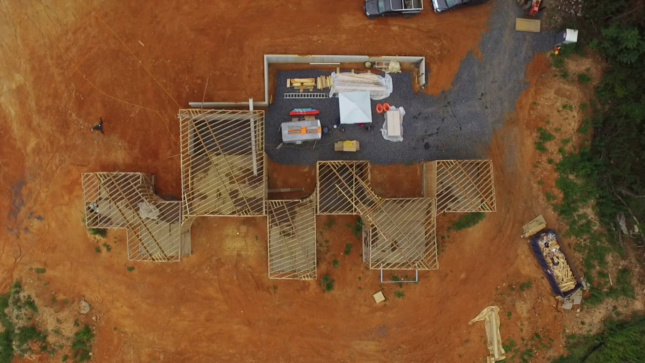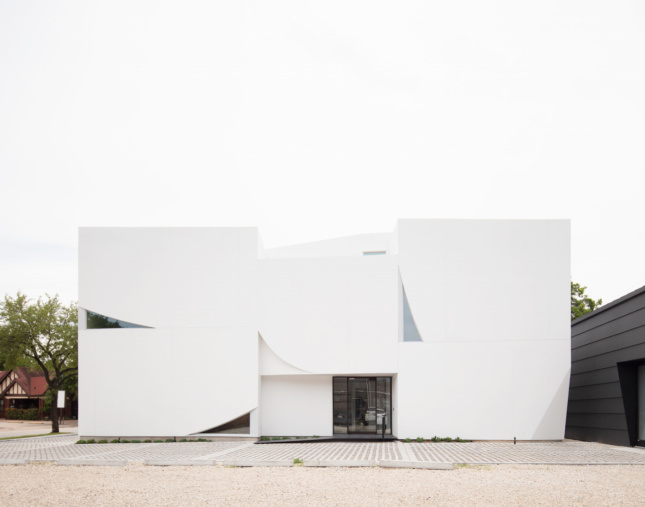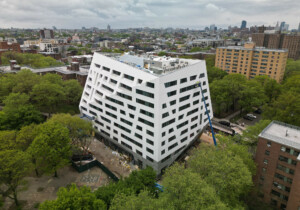The following interview was conducted as part of “Building Practice,” a professional elective course (and now AN interview series) at the Syracuse University School of Architecture, taught by Molly Hunker and Kyle Miller. On October 10, 2019, Kate Kini and Rachael Gaydos, students at Syracuse University, interviewed Troy Schaum and Rosalyne Shieh of SCHAUM/SHIEH.
The following interview has been edited by Kyle Miller and AN for clarity.
This year marks your 10-year anniversary. Congratulations! Can you talk about how starting a practice in 2009, the year after the recession, presented a challenge that may have limited growth?
Troy Schaum: Both of us were teaching when the recession hit. Rosalyne was a Taubman Fellow at the University of Michigan and I was a Wortham Fellow at Rice. What we anticipated would be a brief foray into the academy was extended as a result of the macroeconomic situation in this country. We had to figure out how to work as architects without being hired to work as architects. So we started making our own projects—competition submissions and university-sponsored independent research projects and installations. It was only after we were invited to participate in the Venice Biennale in 2012, curated by David Chipperfield, that we started to get commissioned work. I don’t know if those two things were related, but we started to pick up projects both in New York and Texas, and we very quickly had four additional employees. Our office size hasn’t grown a lot since then, but when we look at the numbers every year, it’s been relatively steady, which is its own form of success.
In response to the challenges of starting a practice at that time, have you used unconventional methods to promote your firm or to attract potential clients?
Rosalyne Shieh: We began our practice in an academic setting with little opportunity to practice in a traditional manner. In 2009, by starting in the midst of the recession, there was little momentum to be lost and the work we made was unsolicited. I don’t mention this so much to bemoan, rather to state the conditions within which we set out and to explain why in the beginning, most of our work was speculative, invested in an alternate economy of ideas and discourse, one partially encapsulated from the macroeconomic situation that professional practice is embedded in. So we may have had a small audience tied to the academy, but we didn’t have clients. We started by thinking about what it meant to make work that nobody was asking for, about what questions could be posed or offerings made through the framework of an architectural project. The parameters and conceptual territory of this early work were partly self-defined but also defined by our educations, conversations with our peers and collaborators, as well as things we were reading and looking at. This was an important incubation period for us, but it didn’t necessarily transition seamlessly into attracting clients and working on commissioned projects.
Troy: What encouraged that transition for us was a desire to work at a certain scale. We were conducting design research and building temporary installations, but we were interested in engaging building[s] at a much larger scale. When we received opportunities to work on larger projects, we realized that the two of us couldn’t do it alone anymore. We had to build an ecosystem of people to support us. All of a sudden we had to develop an economy around the work in order to support the people that were supporting us. At that point, we found ourselves running a business. We didn’t say “no” to a lot of requests, because you never know where certain journeys are going to take you. In 2012 or 2013, we were asked by some relatively young people in Houston if we were interested in designing a music venue. We made some sketches and renderings for a very small amount of money. We just assumed these people would go away and we’d never hear from them again. What actually happened was that they took those renderings all over town and raised significant capital to build the music venue. What also happened was that lots of people who build things in Houston saw the renderings. They didn’t necessarily want to invest in a music venue but were very curious about us as architects. Developers would contact us and request a portfolio of built work. The problem was that we hadn’t actually built anything! It’s a common and unfortunate catch-22, especially for a U.S.-based practice in its earliest stages. That said, some of them hired us anyway.
How do you mediate between presenting your work to a broader public audience versus an audience of architecture students, colleagues, and other professionals?
Troy: This is a huge issue for us, especially as we oscillate between our audiences. We’re both teachers and we both have conversations with very erudite students and colleagues, and we have conversations with people who work out of the back of their trucks and know a lot about building things, but not so much about architectural discourse. The importance and role of communication and the ability to articulate ideas to many different audiences [are] primary to our understanding of architecture. You mentioned two audiences, but there are probably 20 audiences that we communicate with throughout the course of the day, from the people that are going to send us metal samples to the lawyers that are helping us draft contracts for our clients.
Rosalyne: Also, communication is a very personal thing. You have to respond to who you’re talking to. Depending on what it is that each person is able to receive or wants to talk about, you have to meet each other somewhere, and you both need to arrive from where you’re coming. I like to speak with my own voice across different conversations, but communicate differently given the situation or who I’m talking to.
Troy: It’s become very apparent to me that when we talk about audiences in school, we’re talking about collectives. And we’re very interested in creating projects for collectives. There’s a democratizing idea that architecture is for everyone. It is. But, one of the things that I underestimated was how powerful architecture can be for individuals–our individual clients and the contractors who build our projects.

What do you understand to be your responsibility as an architect?
Troy: Wow, that’s a difficult question! Our practice is both of our names for a reason. SCHAUM/SHIEH wasn’t just a default. That decision makes the practice a very personal thing for us. I imagine there’s certain ethics in our work. I believe we have a responsibility to use these professional tools and our ways of seeing the world to be as careful and reflective and deliberate about our decisions and our work, especially when working in cities and in public spaces. To be stewards of the resources that we’re given, to be stewards of opportunities that we’re given to shape cities–these are very important responsibilities.
Rosalyne: I agree and would add that we hope our projects enrich the world and make more connections possible. That’s the aspiration, at least. We hope our efforts lead to building more complexity into the world. One of the quotes that we come back to a lot is this one–it’s included by Jane Jacobs at the beginning of Death and Life of Great American Cities, from Oliver Wendell Holmes Jr.: “Life is an end in itself, and the only question as to whether it is worth living is whether you have enough of it.” He’s talking about the vibrant complexity of civilization and Jacobs connects this to cities as an engine of that. There’s an interest in the pursuit of what we do as architects, but also as people to contribute to more life for more people.
Some architects believe that there should be a separation between being a citizen and being an architect, specifically in relation to political issues and attempt to be as apolitical as possible. With your office, it seems to be the inverse. How much effort do you put into making a project political? Does it come naturally from its inception?
Rosalyne: That’s a good question, and it’s one that comes up again and again in architecture: What is the relationship between architecture and politics? If being political means seeing and engaging structural inequality, I can’t live in a world where those two things can be separated, because it would mean willfully denying a part of reality, if not my own then someone else’s, with whom I share this world. It’s not only an issue of what we believe, but it’s also about lived realities. There could be different reasons why people feel the need to separate these roles. It could be because the very act or idea of the work—its property—requires that its limits are circumscribed. One way to work on something is to isolate or bracket it from other things. Or it might be a matter of survival: the world can be difficult; maybe you’re at capacity with what you can handle, and creative work is a kind of expression that feeds you. Some might have the choice to separate the two where others don’t. Broadly speaking, people undertake creative work for so many different reasons. I would just ask whether your position to proceed in any certain way is predicated upon an invalidation of someone else’s, and if it does, I would find it hard to support. I do not require you to not be in order for myself to be. That said, work that is explicitly political is not the only way to be political as an architect or artist. Godard said: “The problem is not to make political films but to make films politically.” That might mean simply expressing or applying yourself without explanation. There’s no way to escape this question. It’s not fair actually, to say that those worlds should be separate. I can’t say that every project we do is political; we’re not a political practice per se, but I am who I am, who I am, who I am… whether it’s an architect, an educator, a person in the world, a cis-woman, a Taiwanese person, visibly Asian, a daughter of immigrants in the United States, today. The tension of trying to hold all these things together is at the heart of my humanity.
Troy: There’s a certain disciplinary agenda in the work of some practices, and a legacy of a particular kind of formalism. This way of approaching architecture is very different from how we understand practice. One important role of the architect is to construct agreement. For example, when working on White Oak Music Hall, we found ourselves in scenes similar to scenes in Ghostbusters where we were summoned to the mayor’s office at eight in the morning to be reproached regarding an aspect of the project that a certain constituency was not happy with. These explicitly political aspects of practice and this particular project necessitated engagement with a broad audience and a range of issues well beyond the purview of the discipline of architecture. I don’t know how you practice any other way. It’s beautiful that buildings have the ability to engage political issues, and that architects have the ability to engage political issues.

What’s been the most rewarding moment in your professional careers thus far?
Troy: We recently had the opportunity to observe how powerful work can be for an individual. This positive impact is not something you can encounter until you build something. White Oak Music Hall was embedded in a lot of politics around how music is booked in this country. We created White Oak Music Hall and made a lot of sacrifices in order to complete that project. We were criticized by a portion of the local community, but also supported by many diverse groups within the community. Recently, after finding out that we designed White Oak Music Hall, a local musician said to us, “That space you’ve created—we didn’t have a space like that. That’s my temple.” There’s an entire ecosystem of creative people that can now work in this space we designed.
Rosalyne: I agree with that, and I’ll give you pretty much the same answer, but in a more abstract sense. We’ve had that experience a few times with the projects that are out in the world, with both White Oak Music Hall and Transart. You talk to people, and you might not know them well, and they’re like, “I know that project,” and they share some story that gives you an understanding that the project somehow belongs to them. These are the moments when you realize that projects, once they are out there, belong to the world and not just to ourselves. It can come back to us through clients, contractors, or anyone really… when they share a sense of belonging to this thing that we helped create, and that’s a really special moment.











